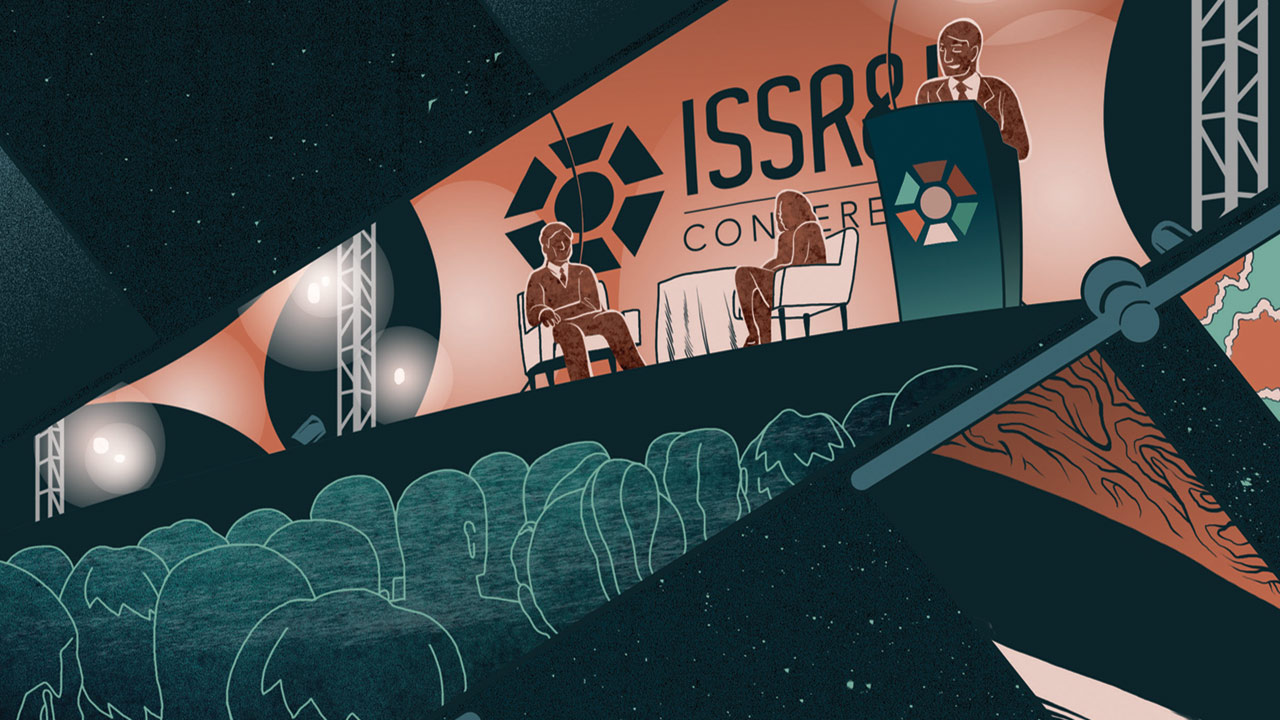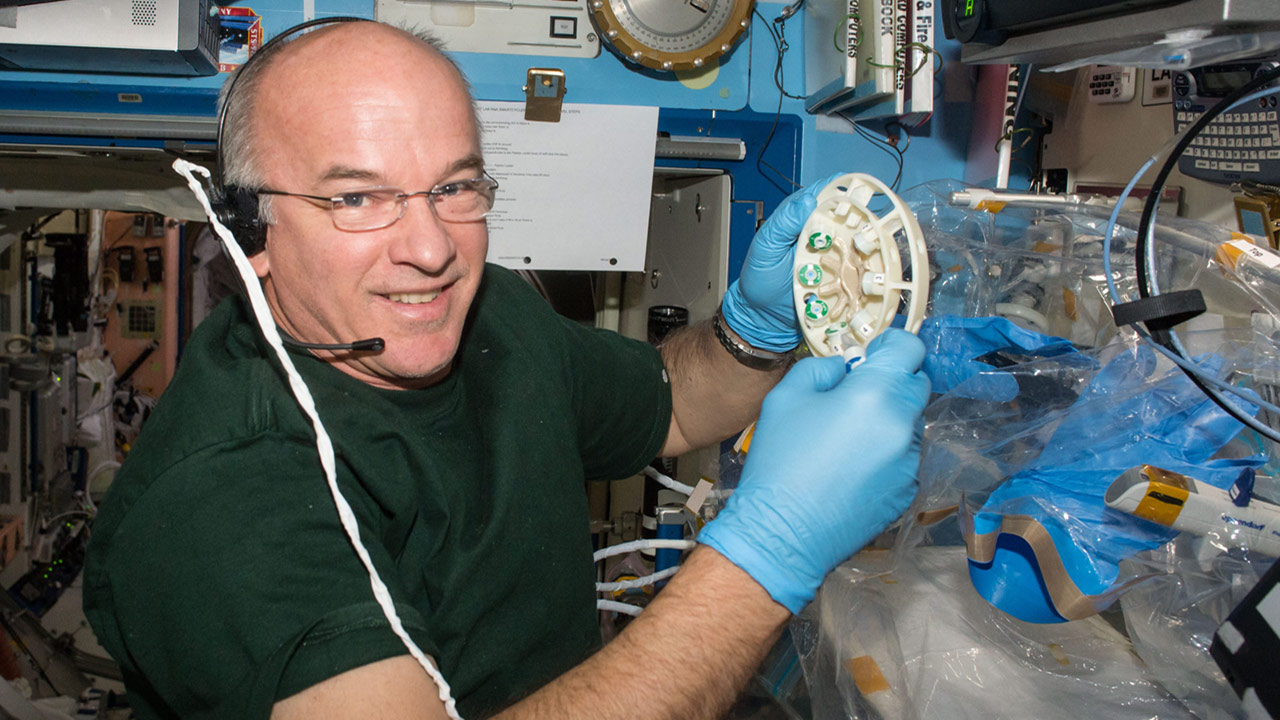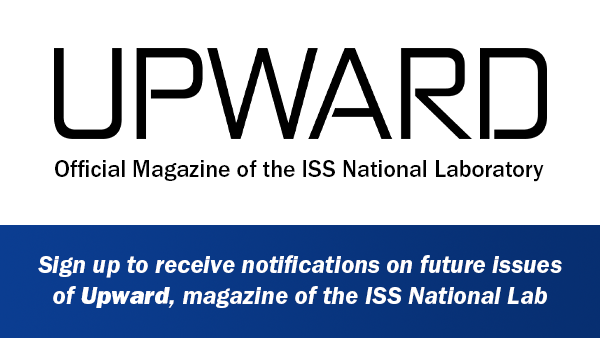
CASIS President and Executive Director Greg Johnson welcomes investigators from academic, commercial, and governmental communities across a variety of disciplines to the 2016 ISS R&D Conference.
What do investigators studying ecosystem productivity, the growth of fungi from the Chernobyl nuclear accident site, the robustness of a new type of osteoporosis drug, and an implantable nanochannel drug delivery system all have in common? These investigators are each using the unique microgravity environment onboard the ISS National Lab to conduct research off of Earth for the benefit of life on Earth.
The annual ISS Research and Development (R&D) Conference brings together a diverse group of investigators from academic, commercial, and governmental communities covering a variety of disciplines—including remote sensing, physical sciences, life sciences, materials science, and technology development—all focused on one thing: leveraging the ISS National Lab to do groundbreaking research not possible on Earth.
The sections below highlight some of the innovative research discussed at the 2016 ISS R&D Conference held in San Diego, California in July.
Studying Ecosystem Productivity From Space
Gross ecosystem production (GEP) is a measurement of energy flow in an ecosystem, a biological community of organisms in a geographical location. Ecologists use the movement of carbon dioxide from the atmosphere into an ecosystem to estimate production because plants breathe in carbon dioxide for photosynthesis. Understanding productivity at the scale of ecosystems is important because it provides a glimpse into the ability of agricultural crops, rangelands, and forests to convert rising levels of carbon dioxide into biomass. GEP data enables scientists to model how changes in carbon dioxide levels in the atmosphere will impact future agricultural production and to predict ecosystem stability.

Map of gross ecosystem production (GEP) derived from HICO imagery from the ISS for the study area around Lethbridge, Alberta, Canada. Image collected July 2, 2013. The triangle indicates the location of the flux tower. The area is a mixture of grassland and crops, resulting in a complex spatial pattern of productivity.
Ecologist Karl Fred Huemmrich, of the University of Maryland, Baltimore County, described the results of his team’s research using hyperspectral remote sensing data from the ISS to evaluate ecosystem productivity on the ground. The team used archived imagery from the Hyperspectral Imager for the Coastal Ocean (HICO), which operated on the ISS from 2009 until 2014.
The orbit of the ISS goes through a repeated pattern of visible daytime observations about every 60 days. The advantage of this orbit is that it allows observations of specific locations on Earth’s surface at different times of the day and year. Conversely, of course, there are times that a location of interest is passed over by the ISS during darkness and thus cannot be observed with visible light sensors.
Huemmrich and his team developed algorithms to correlate archived hyperspectral reflectance data from HICO with ecosystem productivity as determined on the ground. Ground-based sensors on eddy covariance towers placed at hundreds of sites around the world measure carbon dioxide flux between the surrounding ecosystem and the atmosphere. Huemmrich and his team chose four eddy covariance tower sites with varying types of vegetation in the western U.S. and Canada to compare with archived HICO imagery.
“Existing approaches generally use meteorological data and try to predict and model plant responses and therefore productivity,” Huemmrich said. “What we’re trying to do is observe the biochemical state of the plants to then infer how stressed they are and how productive they are. We want to then be able to apply that over regions so we can map variations in gross ecosystem production."
Huemmrich and his team found multiple promising approaches that allowed them to successfully use HICO imagery to map complex variations in GEP across different types of landscape vegetation (forests, shrubs, and warm and cool season grasslands). The team was able to use the data to map both spatial variations (how GEP varied across a specific geographical area) and temporal variations (how GEP varied depending on the season and time of day).
These results demonstrate that the ISS National Lab can be used as an Earth observation platform to study ecosystem productivity using routinely collected hyperspectral remote sensing data. Data from space can supplement eddy covariance tower data from the ground and help scientists and farmers better manage crops as our climate changes.
Testing A New Type of Osteoporosis Therapy

Drs. Kang Ting, Chia Soo, Ben Wu, and Jin Hee Kwak, the research team behind the Systemic Therapy of NELL-1 for Spaceflight-Induced Osteoporosis.
Media Credit: Image courtesy of Peter Bracke
Osteoporosis is the most common bone disease, contributing to 1.5 million fractures and more than $25 billion in healthcare spending each year in the U.S. Current osteoporosis treatments work in one of two ways—by slowing bone breakdown (antiresorptive therapies) or increasing the formation of new bone (anabolic therapies). A new drug, PEGylated NELL-1, has been shown in animal models on the ground to do both. If effective in humans, PEGylated NELL-1 could be developed as a therapy to combat extreme cases of osteoporosis on Earth as well as a countermeasure to spaceflight-induced osteoporosis in astronauts on long-duration missions.
Jin Hee Kwak, of the University of California, Los Angeles, discussed her research (as part of a team led by principal investigator Chia Soo) aimed at testing the effectiveness of PEGylated NELL-1 in treating microgravity-induced osteoporosis in mice onboard the ISS National Lab. Kwak discussed the results of her team’s ground optimization study and preparations for their upcoming flight project, which is part of the Rodent Research-5 (RR-5) mission scheduled to launch to the ISS in a SpaceX Dragon in 2017.
Microgravity onboard the ISS provides an environment for robust, accelerated testing of potential pharmaceuticals such as PEGylated NELL-1.
“Microgravity is known to induce bone loss up to four times faster than models on Earth, and induces an extreme state of osteoporosis that is difficult to mimic by a single osteoporosis model on the ground,” Kwak said. “Microgravity-induced bone loss is also an excellent and unique model of disuse atrophy from disability and immobilization on the ground that frequently occurs with osteoporotic fracture patients.”
In preparation for their flight experiment, Kwak and her team conducted ground-based optimization studies aimed at addressing two changes in experiment design. One was reducing the frequency of administration of the drug from once every seven days (based on previous research) to once every 14 days, as required on the ISS to reduce crew time and handling of the mice. Additionally, the drug is given intravenously on the ground, but in microgravity, another route of drug administration would be needed.
To address these challenges, the team tested PEGylated NELL-1 administered once every two weeks by one of three ways—injection into the space just under the skin, injection into the abdomen, or a combination of the two. The results showed that PEGylated NELL-1 successfully reversed osteoporotic bone loss in mice on the ground when given once every 14 days and that injection into the abdomen was the most effective route.
The team’s flight experiment on the RR-5 mission will be unique because 20 mice will be returned live to Earth from the ISS halfway through the nine-week experiment, while 20 mice will continue treatment in orbit. The mice returned to Earth will recover while continuing treatment in normal gravity until the end of the study period.
Growing Useful Fungi in Orbit
On Earth, certain strains of fungi are known to generate bioactive compounds that have been used to produce important products, such as antibiotics, immunosuppressant drugs, anticancer therapies, and even antifungal agents for crop protection. Research has shown that the production of many bioactive compounds is affected by the fungi’s growth environment and response to stress. Thus, growing fungi in the stressful growth environment of microgravity could lead to the production of novel compounds for use in medicine and agriculture on Earth.

Colony morphologies of the Chernobyl fungal strains that were exposed to microgravity in order to characterize novel bioactive compounds
Shown here are Cladosporium sphaerospermum and Cladosporium cladosporioides
Kasthuri Venkateswaran, of NASA’s Jet Propulsion Laboratory, discussed his team’s research focused on growing certain strains of fungi on the ISS National Lab. The fungal strains chosen for this project were isolated from in and around the Chernobyl nuclear accident site. In the time since the Chernobyl accident in 1986, thousands of fungi from around the accident area have been collected and analyzed. A subset of these fungal strains was found to display a unique phenomenon—instead of growing away from sources of radiation, they actually grow toward the radiation source.
These specific fungal strains have been found in terrestrial studies to produce novel, beneficial compounds useful for humans. Thus, by exposing these unique fungal strains to the added variable of microgravity onboard the ISS, Venkateswaran anticipates that they may produce additional, novel compounds that may be beneficial for use on Earth.
“The strains isolated in and around the Chernobyl accident site produce agricultural- and pharmaceutical-related natural products, so we are trying to see if those strains under the stressful microgravity condition produce different secondary metabolites,” Venkateswaran said.
Based on ground studies to determine which Chernobyl fungi are the most resistant to radiation and the best candidates to send to the ISS, the team selected eight strains to grow for 14 days on the ISS and in ground-based controls. The experiment launched to the ISS on SpaceX CRS-9 in July and returned to the ground on SpaceX CRS-9 in August. The team will analyze the bioactive compounds produced by the fungi in space and on the ground to identify natural compounds to benefit agriculture and medicine.
Developing Nanochannel Technology For Controlled Drug Delivery

3-D rendition of the diffusion of nanoparticles through a confining slit-nanochannel
Alessandro Grattoni, of the Methodist Hospital Research Institute in Houston, described his team’s research focused on developing nanochannel technology for an implantable controlled drug delivery system. Grattoni discussed his team’s recent flight experiment aimed at better understanding how molecules diffuse in confined spaces. He also discussed the team’s research on remotely controlled implantable drug delivery systems.
Many chronic conditions require long-term therapeutics that are often administered orally or through injections. When administered in these ways, there is an initial burst of concentrated drug in the patient’s blood, followed by a decrease.
“For many applications in which you want to maintain a therapeutic range for an extended period of time—for months or even for the lifetime of the patient—this kind of approach is rudimentary,” Grattoni said. “We have been looking at ways of targeting the therapeutic range and maintaining it for the entire time that is required.”
To do this, Grattoni and his team are working to develop an implantable device that can deliver a steady and metered dose of the drug through diffusion, without the need for a pump or even power. The nanochannel system consists of membranes with very small channels—roughly two to three times the size of the drug molecule to be delivered. The drug is contained in a reservoir that can be easily refilled by an injection through the patient’s skin. The release of the drug can be adjusted by applying an electrical field across the nanochannels in a way that interrupts and then reactivates the release.
In designing these systems, Grattoni and his team needed to understand how molecules of different size, shape, and charge diffuse across the nanochannels. To do this, they needed to explore in microgravity how fluids behave in confined spaces. It is not possible to directly observe individual small molecules diffusing across nanoscale channels; microscopes cannot provide the necessary resolution for that. However, in microgravity, a surrogate model represented by fluorescent microparticles in microchannels can, in specific circumstances, be highly representative of smaller molecules in nanochannels.
Thus, Grattoni and his team scaled up their experiment to the microscale, preserving some peculiar features of their nanoscale system, for a study to be carried out using the light microscopy module (which features a modified Leica RXA microscope) onboard the ISS National Lab. The experiment launched on SpaceX CRS-8, and the team is now analyzing the data.
Grattoni and his team are also working to develop technology for remotely controlled implantable drug delivery systems. Such systems would not only benefit patients on Earth but also could be an enabling technology for rodent research on the ISS. The drug delivery implant could be inserted in rodents before flight, and instead of having a crew member perform a complex procedure to administer doses of a drug, an investigator on the ground could remotely control the drug release in the mice.
New Ideas and Innovation
Each year, investigators from across disciplines and institutions converge at the ISS R&D Conference to exchange ideas, spark innovation, and push their research to new heights. The ISS National Lab is a research facility unlike any on Earth, opening the door for new discoveries that cannot be made on the ground.
“The scale and scope of investigations possible on the ISS National Lab is astounding,” said CASIS Deputy Chief Scientist Michael Roberts. “From entire ecosystems to drug molecules in nanochannels, anything is possible.”








